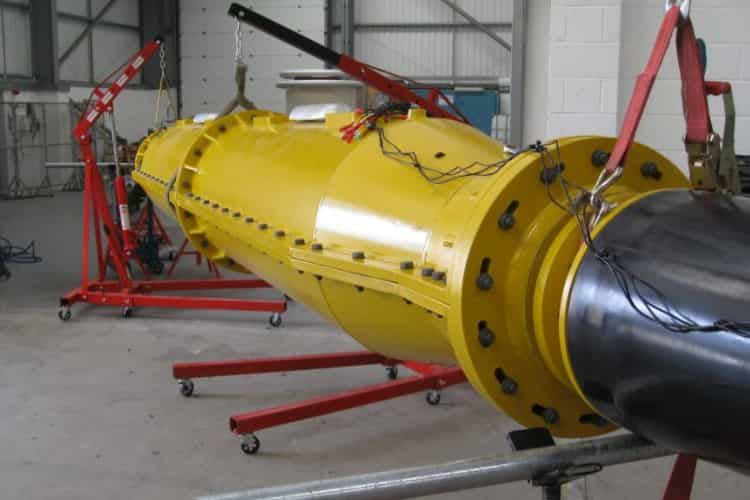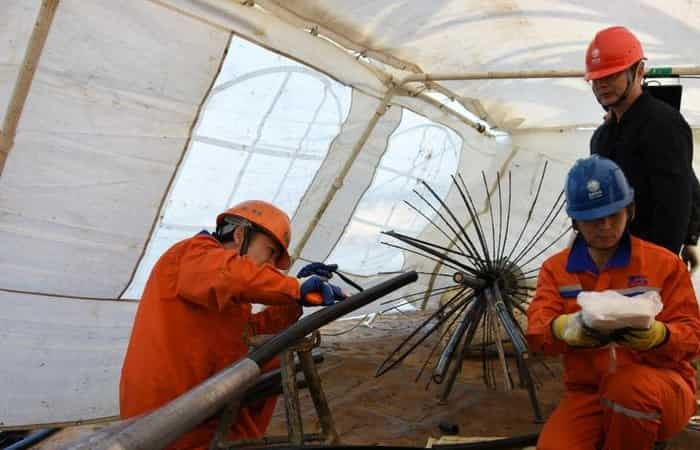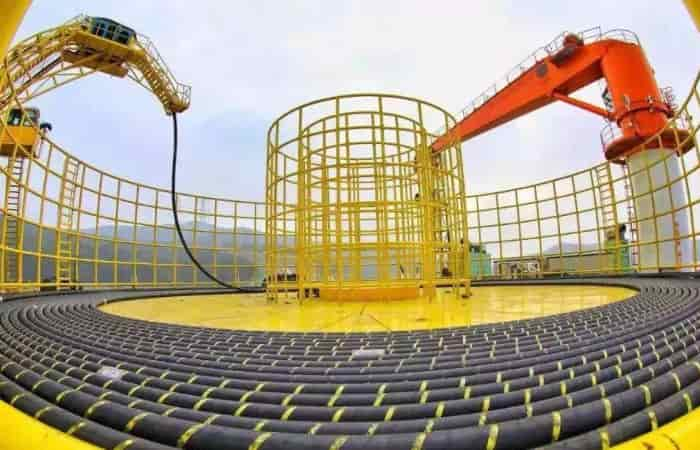
Denizaltı kabloları modern telekomünikasyon için hayati öneme sahiptir, Kıtalar arasında ve okyanuslar altında küresel veri aktarımını güçlendirmek. Bu kablolar çok sayıda zorlukla karşı karşıyadır, çevresel faktörlerden fiziksel hasara kadar, Sağlam onarım ve bakım çözümleri gerektiren. Bunun merkezinde denizaltı kablosu eklemi, Bu sualtı iletişim yaşam çizgilerini korumada ve onarmada önemli bir bileşen. Bu kapsamlı kılavuzda, Biz Dosense kablosu,denizaltı kablosu ortak fabrikası olarak, denizaltı kablo derzlerini keşfedecek, üreticileri dahil, fiyatlandırma, kurulum, ve dahası, Sualtı altyapısının bu kritik yönünü tam olarak anlamak için size.
Denizaltı kablosu eklemi nedir?
Denizaltı kablo eklemi, denizaltı kablolarını bağlamak veya onarmak için kullanılan özel bir cihazdır., okyanus tabanı boyunca uzanan ve farklı kıtaları veya adaları birbirine bağlayan. Bu kablolar sert koşullara tabidir, baskı dahil, Sıcaklık varyasyonları, ve deniz faaliyetlerinden elde edilen potansiyel hasar. Eklem, kablonun işlevinde sürekliliği ve güvenilirliği sağlamak için tasarlanmıştır., Su geçirmez ve dayanıklı bir bağlantı veya onarım sağlamak.
Denizaltı Kablo Eklemleri Neden Önemlidir?.
1.Hizmetin sürekliliği: Denizaltı Kablo Eklemleri, kablo bölümleri arasında kesintisiz bir bağlantı sağlayarak kesintisiz veri iletimini sağlar.
2.Dayanıklılık: Bu eklemler, sert sualtı ortamına dayanacak şekilde tasarlanmıştır, basınç ve korozyon dahil.
3.Onarım özelliği: Hasar durumunda, Kablo derzleri verimli ve etkili onarımlara izin verir, Kesinti süresini en aza indirme.
Denizaltı kablo eklemleri türleri
Denizaltı Kablosu eklemleri çeşitli tiplerde gelir, her biri belirli ihtiyaç ve koşulları ele almak için tasarlanmıştır.
Denizaltı Kablosu eklemleri çeşitli tiplerde gelir, her biri belirli ihtiyaç ve koşulları ele almak için tasarlanmıştır.
1. Düz eklemler
Aynı tip denizaltı kablosunun iki segmentini bağlamak için düz eklemler kullanılır. Tasarım ve işlev konusunda basittirler, Kablo spesifikasyonlarını değiştirmeden kabloları uzatmak veya yeni bağlantılar kurmak için tasarlanmıştır.
Başvuru: Benzer bir denizaltı kablosunun iki bölümünü bağlama.
Tasarım: Tipik olarak iki kablo ucunu hizalamayı ve sızdırmaz hale getirmeyi içerir.
2. Şube derzleri
Şube derzleri, ana kabloyu yeni bir yöne yönlendirecek veya ikincil çizgileri bağlamak için dalın kapalı. Bu derzler, ek bağlantılara ve hizalamaya ihtiyaç nedeniyle daha karmaşıktır..
Başvuru: Bir denizaltı kablo ağında şubeler veya sapmalar oluşturmak.
Tasarım: Çoklu konektörler ve sızdırmazlık mekanizmaları içerir.
3. Onarım Eklemleri
Onarım derzleri hasarlı denizaltı kablolarını düzeltmek için kullanılır. Kablonun işlevselliğini geri yüklerler ve verileri güvenilir bir şekilde iletmeye devam edebileceğinden emin olurlar..
Başvuru: Hasarlı veya kırık denizaltı kablolarının onarımı.
Tasarım: Hasarı ele almak için gelişmiş sızdırmazlık ve takviye içerir.

Bir denizaltı eklem kitinin temel bileşenleri
A denizaltı eklem kiti bir denizaltı kablosu eklemini monte etmek için gereken tüm bileşenleri içeren kapsamlı bir pakettir.. Bu kitler hem kurulum hem de onarım görevleri için gereklidir. İşte tipik olarak bir denizaltı eklem kitine dahil edilen temel bileşenler:
1. Ortak gövde
Eklem gövdesi, eklemin ana yapısal bileşenidir. Kablo bağlantılarını barındırır ve basınç ve nem gibi çevresel faktörlere karşı koruma sağlar.
İşlev: Kablo bağlantılarını evler ve hizalar.
Malzeme: Genellikle dayanıklıdan yapılır, Basınca dayanıklı malzemeler.
2. Sızdırmazlık unsurları
Sızdırmazlık unsurları, eklemin su geçirmez olmasını sağlamak için çok önemlidir. Su girişini önlerler, kabloya zarar verebilir ve performansını düşürebilir.
İşlev: Kablo ve eklem gövdesi etrafında su geçirmez bir conta sağlayın.
Malzeme: Genellikle elastomerlerden veya diğer su geçirmez malzemelerden yapılmıştır.
3. Konektörler
İki kablo bölümüne katılmak veya hasarlı kabloyu onarmak için konektörler kullanılır. Kablo uçları arasında uygun elektrik ve mekanik bağlantılar sağlarlar.
İşlev: Kablo segmentleri arasında elektrik bağlantısı oluşturun.
Tasarım: Kablonun özelliklerine uygun pimler veya terminaller içerir.
4. Takviye malzemeleri
Takviye malzemeleri eklemi güçlendirmek ve dış gerilmelerden korumak için kullanılır. Bu malzemeler, eklemin basınç altında sabit ve güvenli kalmasını sağlar.
İşlev: Eklem için ek güç ve koruma sağlayın.
Malzeme: Tipik olarak kompozit malzemeler veya metal takviyeleri içerir.
5. Isı büzülme borusu
Eklemi dış elemanlardan yalıtmak ve korumak için ısı büzülme borusu kullanılır. Isıtıldığında küçülür, eklem etrafında sıkı bir conta oluşturmak.
İşlev: Eklemi çevresel hasardan yalıtım ve koruyun.
Malzeme: Isıtma üzerine küçülen ısıya duyarlı plastik.
6. Jel veya saksı bileşiği
Jel veya saksı bileşikleri, eklem içindeki boşlukları doldurmak için kullanılır, Ek koruma ve yalıtım sağlamak. Bu bileşikler su girişini önlemeye yardımcı olur ve mekanik destek sağlar.
İşlev: Boşlukları doldurun ve yalıtım ve koruma sağlayın.
Malzeme: Silikon bazlı veya epoksi bileşikleri.
Denizaltı Kablosu Eklemleri Kurulumu
Uygun kurulum denizaltı kablosu Uzun vadeli güvenilirlik ve performansın sağlanması için ortak gereklidir. Süreç birkaç kritik adım içerir:
1. Hazırlık
Hazırlık başarılı bir kurulumun anahtarıdır. Bu, sitenin değerlendirilmesini içerir, Kablo uçlarını hazırlamak, ve tüm bileşenlerin hazır olmasını sağlamak.
Site Değerlendirmesi: Eklem için uygun olduğundan emin olmak için kurulum alanını inceleyin.
Kablo Hazırlama: Yalıtımları kablo uçlarından çıkarın ve uygun bağlantıyı sağlamak için temizleyin.
2. Ortak montaj
Eklem, üreticinin özelliklerine göre monte edilir.. Bu, konektörlerin takılmasını içerir, Sızdırmazlık unsurları, ve takviye malzemeleri.
Toplantı: Tüm bileşenlerin doğru bir şekilde hizalandığından ve sabitlendiğinden emin olmak için talimatları izleyin.
Test: Eklemin doğru bir şekilde monte edildiğinden ve tüm bağlantıların güvenli olduğundan emin olmak için ön testler yapın.
3. Dağıtım
Eklem, okyanus katındaki son konumuna yerleştirildi. Bu, kabloya veya ekleme zarar vermekten kaçınmak için dikkatli bir kullanım gerektirir.
Dağıtım yöntemleri: Uzaktan çalıştırılan araçlarla donatılmış özel gemiler kullanın (ROV'ler) veya eklemi konumlandırmak için dalgıçlar.
İşleme: Fiziksel hasardan kaçınmak için eklemin dikkatle kullanıldığından emin olun.
4. Son Çekler
Dağıtımdan sonra, Eklemin doğru çalıştığını ve kurulumun tamamlandığını doğrulamak için son denetimler ve testler yapın.
Denetleme: Herhangi bir hasar veya yanlış hizalama belirtisi olup olmadığını kontrol edin.
Test: Eklemin çalıştığından emin olmak için basınç testleri ve işlevsellik kontrolleri yapın.
Kurulum sonrası faaliyetler
1.Belgeler ve Raporlama
Kurulum işleminin tüm yönlerini belgeleyin:
Kurulum raporu: Kurulum sürecini özetleyen ayrıntılı bir rapor hazırlayın, kablo yolu, ve karşılaşılan sorunlar.
Yapılı çizimler: Son kablo rotasını ve kurulum ayrıntılarını gösteren çizimler oluşturun.
2.Devam eden bakım ve izleme
Denizaltı kablosunun uzun vadeli güvenilirliğini sağlamak için düzenli bakım ve izleme gereklidir..
Rutin denetimler: Kablonun durumunu kontrol etmek için ROV'ları veya diğer teknolojileri kullanarak periyodik denetimler yapın.
Bakım planı: Potansiyel sorunları ele almak ve kablonun iyi durumda kalmasını sağlamak için bir bakım planı geliştirin.

Zorluklar ve çözümler
1 Çevresel Zorluklar
Deniz ortamı çeşitli zorluklar sunar:
Güçlü akımlar: Güçlü okyanus akımlarını yönetmek için gelişmiş kablo döşeme teknikleri ve ekipmanları kullanın.
Deniz yatağı engelleri: Sualtı dağları veya gemi enkazları gibi engelleri belirleyin ve gezin.
2 Teknik zorluklar
Teknik zorluklar arasında:
Kablo hasarı: Sağlam kablo koruma yöntemlerini kullanın ve hasarı önlemek ve ele almak için düzenli denetimler yapın.
Karmaşık ekleme: Doğru ve güvenilir ekleme sağlamak için yetenekli teknisyenleri ve yüksek kaliteli ekipmanları kullanın.
Denizaltı kablosu ortak fabrikası ve denizaltı kablo onarım şirketi nasıl seçilir
Biz,Dozaj Kablosu,sualtı kablo sisteminizin güvenilirliğini ve verimliliğini sağlamak için denizaltı kablosu onarımları için doğru şirket çok önemlidir.. İşte dikkate alınması gereken bazı faktörler:
1. Deneyim ve Uzmanlık
Denizaltı Kablosu Eklem Onarımı'nda kanıtlanmış bir geçmişe sahip bir şirket seçin. Deneyimli şirketler, karmaşık onarım senaryolarını etkili bir şekilde ele alacak gerekli bilgi ve becerilere sahip olacaktır..
2. Teknoloji ve Ekipman
Şirketin kablo birleştirme ve onarım için gelişmiş teknoloji ve ekipman kullandığından emin olun. Buna modern birleştirme kitleri içerir, Test Ekipmanı, ve dağıtım araçları.
3. Hizmet ve Destek
Şirket tarafından sunulan müşteri hizmetleri ve destek seviyesini düşünün. Güvenilir Hizmet, acil durumlara derhal yanıt içerir, teknik destek, ve kapsamlı onarım hizmetleri.
4. İtibar
Müşteri referanslarını ve vaka çalışmalarını inceleyerek şirketin sektördeki itibarını kontrol edin. Saygın bir şirket önceki müşterilerden olumlu geri bildirim alacak.
5. Maliyet ve sözleşmeler
Hizmetlerin maliyetini değerlendirin ve sağlanan hizmetlerin kalitesi ve aralığı ile karşılaştırın. Uzun vadeli sözleşmeler veya hizmet anlaşmaları daha iyi değer ve güvenilirlik sunabilir.
6. Uyum ve Standartlar
Şirketin denizaltı kablosu onarımları için endüstri standartlarına ve düzenlemelerine bağlı olduğundan emin olun. Başarılı onarımlar için güvenlik ve kalite standartlarına uyum gereklidir.
Denizaltı kablosu eklemleri için bakım ve bakım
Denizaltı Kablosu Eklemlerinin Uzun Ömür ve Performansını Sağlamak İçin Uygun Bakım Çok Önemlidir. Düzenli denetimler ve zamanında onarımlar büyük sorunları önleyebilir ve kablo sisteminin ömrünü uzatabilir.
1. Rutin denetimler
Herhangi bir aşınma belirtisini belirlemek için denizaltı kablo eklemlerinin düzenli denetimlerini yapın, zarar, veya korozyon. Rutin kontroller potansiyel sorunları erken yakalamaya ve daha büyük sorunları önlemeye yardımcı olur.
Sıklık: Kablonun çalışma koşullarına ve üretici önerilerine göre denetimler planlayın.
Muayene yöntemleri: Sualtı denetimleri için uzaktan izleme teknolojilerini veya ROV'ları kullanın.
2. Zamanında onarım
Daha fazla hasarı önlemek için herhangi bir sorunu derhal ele alın. Zamanında onarım, kesinti süresini önleyebilir ve kablo sisteminin bütünlüğünü koruyabilir.
Onarım işlemi: Hasarlı eklemleri onarmak veya değiştirmek için uygun prosedürleri izleyin.
Acil müdahale: Hizmet kesintilerini en aza indirmek için acil onarımlar için bir plan var.
3. Dokümantasyon
Tüm denetimlerin ayrıntılı kayıtlarını saklayın, onarımlar, ve bakım faaliyetleri. Bu dokümantasyon, kablonun durumunu izlemeye yardımcı olur ve gelecekteki bakım planlamasında yardımcı olur.
Kayıtlar: Teftiş günlüklerini koruyun, onarımlar, ve kablo sisteminde yapılan değişiklikler.
Raporlama: Bunları ele almak için alınan sorunları ve eylemleri belgeleyin.
Denizaltı kablosu eklemleri fiyat
Denizaltı kablo eklemlerinin maliyeti, çeşitli faktörlere göre büyük ölçüde değişebilir:
1. Eklem tipi
Düz eklemler: Karmaşık dallanma olmadan basit bağlantılar içerdikleri için genellikle daha ucuz.
Şube derzleri: Bunlar, karmaşıklıkları ve ek bileşenlere duyulan ihtiyaç nedeniyle daha maliyetli olabilir..
Onarım Eklemleri: Fiyatlandırma, hasarın derecesine ve gereken onarımın karmaşıklığına bağlı olarak değişebilir.
2. Kablo özellikleri
Birleştirilen veya onarılan denizaltı kablosunun türü ve özellikleri maliyeti önemli ölçüde etkiler. Gelişmiş özelliklere sahip yüksek kapasiteli kablolar daha sofistike eklemler gerektirecektir, genel fiyatı etkilemek.
3. Üretici firma
Farklı üreticiler, teknolojilerine göre değişen fiyatlandırma yapılarına sahiptir, marka itibarı, ve kullanılan malzemelerin kalitesi. Genel olarak, Güvenilirlik için üne sahip önde gelen markalar daha yüksek fiyatlara komuta edebilir.
4. Ek Özellikler
Ek özelliklere sahip eklemler, gelişmiş dayanıklılık gibi, Gelişmiş sızdırmazlık teknolojileri, veya özel malzemeler, genellikle daha pahalı olacak.
5. Sipariş miktarı
Toplu alımlar veya uzun vadeli sözleşmeler.
Dozne Kablosu,Önde gelen denizaltı kablosu eklemleri üreticileri
Biz,Dozaj Kablosu, Üreticiler denizaltı kablosu eklemleri üretme konusunda uzmanlaşmıştır, her biri farklı gereksinimlere göre uyarlanmış bir dizi çözüm sunar. Dayanıklılık ve güvenilirlik için tasarlanmış çeşitli denizaltı kablo eklemleri sunuyoruz. Sualtı kablosu birleştirme kitleri, aşırı sualtı koşullarına dayanacak şekilde tasarlanmıştır ve dünya çapında sağlam performansları ve ileri teknolojileri için kullanılır.
Biz, denizaltı kablosu çözümleriyle ünlüdür. Kapsamlı birleştirme kitleri ve katı kalite standartlarını karşılayan onarım çözümleri sunuyoruz, Uzun vadeli performans ve minimum bakım ihtiyaçlarını sağlamak.
Denizaltı kablo kitlerimiz ayrıca çözümler, sualtı ortamlarında talep eden yüksek performans ve güvenilirliğe odaklanıyor.
Denizaltı Kablosu Kitleri Sonuç
Denizaltı Kablosu Eklemi, dünyamızı birbirine bağlayan hayati sualtı iletişim altyapısını korumak ve onarmak için ayrılmazdır.. Eklem türlerini anlamak, lider üreticiler, fiyatlandırma, ve kurulum süreçleri, bu kritik bileşenlerin güvenilir ve etkili bir şekilde çalışmasını sağlamaya yardımcı olur.
Saygın üreticileri ve onarım şirketlerini seçerek, Yüksek kaliteli birleştirme kitlerine yatırım yapmak, ve kurulum için en iyi uygulamaları takip etmek, Denizaltı kablo sistemlerinizin uzun vadeli performansını ve istikrarını sağlayabilirsiniz.. İster yeni bir kurulum veya onarım durumu ile uğraşıyor olun, Bu unsurları net bir şekilde anlamak, bilinçli kararlar almanıza ve sağlam bir sualtı iletişim ağı sürdürmenize yardımcı olacaktır..
